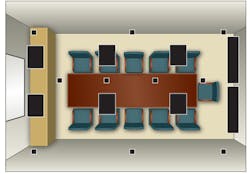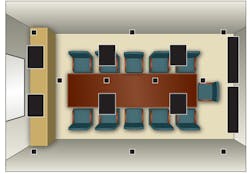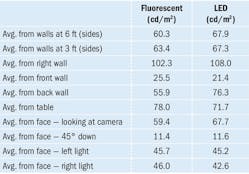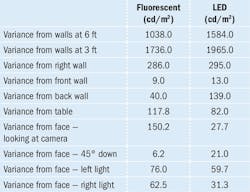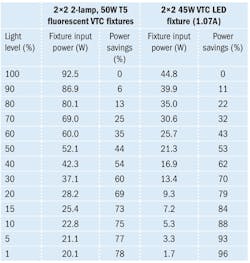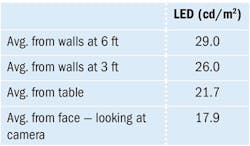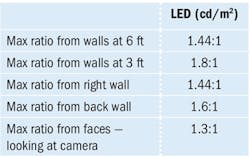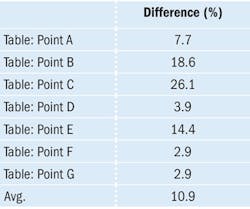JIM YORGEY reports on a case study of LED lighting used to illuminate a video conferencing room, matching the photometric performance of legacy sources while delivering significant energy benefits.
LED-based lighting is increasingly popular due to longevity and energy savings and is being deployed in commercial spaces across a broad section of usages. Some lighting designers and specifiers, however, have been slow to install solid-state lighting (SSL) in rooms used for Video Teleconferencing (VTC) after having learned how to optimally light VTC areas using fluorescent fixtures. Today, however, LEDs can provide even better lighting than fluorescent sources for VTC needs. In this article, we will discuss a prototypical VTC lighting design (see figure) and the need for controls to realize the ideal experience for conference participants.
The current state of video conferencing
Today, VTC can take place in a variety of formats with applications ranging from individual desktop computer or handheld devices to dedicated rooms for multiple attendees or training rooms for distance learning activities. Desktop VTC is convenient, and appropriate in some cases, but VTC rooms with full-function video conferencing codecs (coders decoders) and high-definition (HD) cameras are still needed for many of the applications that involve multiple people at one or more locations, particularly where reduced travel time and cost and increased productivity are the key benefits. This type of space is particularly valuable for large-scale sales, marketing, and management meetings, engineering design collaboration, manufacturing and production updates, and legal departments among other uses.
Another important use of VTC rooms is in distance learning/training programs that benefit from high-end VTC systems including higher education remote learning, customer training, sales and employee training, and corporate business updates. A sense of community, collaboration, and shared purpose is most effectively achieved by simulating the in-person environment in training rooms, lecture halls, classrooms, and even small huddle rooms where brainstorming and idea sharing spurs innovation.
In each case, HD-level images and quality audio are required to maximize the experience. In addition, VTC room technology is often easier to use, cost effective, and allows connectivity to be achieved almost anywhere provided there is reliable connection to the remote location.
Room-based video conferencing provides clearer, face-to-face images, enabling all participants to benefit from the facial expressions and body language cues of everyone in the conference. Because a significant percentage of communication is actually non-verbal, VTC rooms can do a better job of promoting understanding and clarity among conference participants than desktop or handheld devices. Participants are also more likely to stay focused on the discussion when video is implemented, and when they are part of an active, observant group of people.
A typical video conferencing space measures approximately 23×13 ft and includes indirect lighting from troffers, wall washers, and recessed direct lighting.
Challenges in a VTC room
Lighting a VTC environment presents a unique challenge - simultaneously providing excellent visual access to participants in the room as well as participants in remote locations. The lighting must accommodate the visual requirements of the people and the camera, and provide visibility of any display materials, especially to remote participants. Achieving the proper lighting balance requires the right fixtures and controls.
Linear fluorescent sources have long been used to provide effective, uniform lighting in VTC environments. As LED alternatives offer the opportunity to save energy and reduce costs, lighting designers are looking for assurance that these solutions can also deliver similar, or better, results and to understand the additional benefits associated with using LEDs. Dimming controls are essential to creating that ideal solution in VTC environments regardless of the source, and appropriate control solutions are the other key to success.
VTC lighting principles
New research provides tangible data that will allow designers and facility managers to be more comfortable with the use of LED fixtures and controls in VTC environments, and to confidently include LED solutions into VTC room specifications and applications. During a video conference the camera doesn't "see" the way the human eye does. Improper lighting can cause the camera to produce saturated images or images with dark shadows on them, resulting in poor picture quality for remote participants.
The right combination of strategically placed fixtures improves vertical illumination, creates uniform lighting on surfaces and participants, and with the addition of controls, enhances the ability to adjust contrast in the space. Critical contrast needs include:
• Participant-to-rear-walls
• Participant-to-side-walls
• Participant-to-work-surface
• Display-wall-to-video-display
Other factors, including room color and color/texture of furnishings, can also contribute to or detract from effective VTC room design.
To further ensure image clarity, it is important to implement a solution that offers fluorescent fixtures with dimming ballasts and/or LED fixtures with dimmable drivers in various form factors to fit different space types and applications.
In either case, a combination of 1×2-ft and 2×2-ft indirect fixtures provides both vertical and horizontal illumination, and helps produce images that have better contrast and sharpness. The right combination of fixtures ensures high-quality lighting on the participants, walls, and table surfaces, and the area around the display, screen, or monitor.
VTC in several space types
Ideally, a corporate space will have a dedicated video conferencing room, but space is often at a premium, and the guidelines we are defining are advantageous in a number of spaces that may be used for meetings, conferences, and educational activity, such as:
• VTC rooms
• Telepresence rooms
• Distance learning spaces
• Training rooms
• Board rooms and conference rooms that incorporate video capabilities
Now let's discuss legacy fluorescent lighting relative to new SSL options. Over the course of many years, fluorescent fixtures have proven to provide even, controllable lighting in VTC spaces, and lighting designers may be hesitant to veer away from fluorescent solutions without a clear understanding that LEDs offer equivalent lighting with additional advantages.
TABLE 1. A comparison of the average luminance provided by fluorescent and LED lighting at various positions within the 3-D space in a video conference room.
LED fixtures and controls are becoming less expensive and more widely available, and now they offer a viable alternative design solution, delivering benefits that make LED fixtures highly desirable in virtually any VTC application. They are energy efficient, offer long life and lower heat dissipation, and by working with the right provider, offer guaranteed compatibility between the fixture and the controls.
Consider the following benefits of SSL:
• Efficient - LEDs use less energy initially, and they save energy at a roughly 1:1 ratio as they are dimmed
• Uniform light levels/consistent color temperature - LEDs deliver more consistent color temperature, with little degradation or color shift over their lifetimes
• Longer lifetime - LEDs consistently deliver 50,000+ hour life, even longer when LEDs are dimmed
• Lower heat dissipation - LEDs dissipate very little heat, further increasing energy savings by reducing demand on HVAC cooling systems
• Guaranteed compatibility - The LED light source is included in the fixture, ensuring compatibility between LED module and driver. By choosing a manufacturer that specifically provides fixtures and controls together, you can guarantee compatibility and smooth, flicker-free dimming
• Lighting performance - LED fixtures provide the same glare-free lighting as their fluorescent counterparts
Compatibility between the driver and the fixture is key to LED lighting performance. The selection of an appropriate driver is not limited to just making sure it matches the LED module being used. The driver is the primary component that determines the best-possible dimming capabilities of the LED lamp or fixture. It is also important to understand what mechanism the LED driver uses to achieve dimming: pulsewidth modulation (PWM) or constant current reduction (CCR). Drivers using CCR are critical for video conferencing applications in order to ensure good performance on camera.
Optimized solutions
The IES (Illuminating Engineering Society) standard IESNA DG-17-05 goes into great detail to explain the importance of environment in creating a space ideal for VTC functions. It provides background on optics and details explaining what needs to be done to successfully implement a VTC space. Among the details, it describes what efforts should be taken to ensure appropriate lighting within a space.
The IESNA DG-17-05 standard calls out ideal specifications for light sources, including a 3000-3500K range for CCT and a CRI of 80 or higher. It also emphasizes the importance of meeting the minimum light level requirements of the camera and providing even contrasts in lighting throughout different parts of the room in order to prevent saturation and washouts.
The standard strongly suggests the use of controls in order to achieve this balance of light levels, to provide the minimum quantity of light without being overlit, and to provide good contrast ratios. A dimming system facilitates the ability to adjust the light levels within the space in order to ensure the proper balance of light.
Modeling versus performance
When designing a space with such specific requirements, it is vital that the solution can be modeled and the results accurately predicted. Predictive models allow for a designer to see what the solution will look like in terms of fixture layout and light output, without investing the time and money in a physical mockup of the space. A trusted model delivers confidence that the proposed solution will meet the space requirements prior to purchasing a piece of equipment.
Predictive modeling can be done using IES files and modeling software. By modeling the space, designing and tweaking the fixture layout, and including the IES file photometric data for the specific fixtures, the actual photometric layout of the room can be created and analyzed. The model enables the user to observe and/or analyze the light levels throughout the space as well as the contrasts between dark and bright spots. This allows for further consideration regarding fixture type and placement as well as the application of control systems.
Case in point: A before/after analysis
Now let's consider an actual project with the lighting design depicted in the opening figure. The larger rectangles represent the aforementioned 1×2 and 2×2 troffer or pendant fixtures that deliver indirect light. The smaller squares along each wall represent wall-wash fixtures. And the small squares down the center represent recessed downlights.
What follows is a comparison of the use of fluorescent fixtures and controls versus LED fixtures that were used in a recently designed VTC room. The data will demonstrate that LED solutions can provide the same, flicker-free 1% dimming previously only available with a fluorescent solution, with lower energy use.
TABLE 2. A comparison of the average variance in luminance for the fluorescent and LED installation.
Table 1 shows average luminance data for the two options with the lights at 100%. The light output of the LED solution is capable of producing the same quantity of light as the fluorescent solution. Looking at the variance data in Table 2, we can see that the variation in light output across the different surfaces is also very similar.
TABLE 3. An electrical comparison of power used by fluorescent and LED lighting at different light levels.
The variance in the data set is a measurement in the spread of the values away from the mean of the set. In this analysis, the measurements can be used to represent overall difference in light measurements along a surface. It cannot be determined from this data set what is an acceptable variance for each surface, but its purpose is to compare the overall light environment provided by the two solutions.
Photometric similarities and differences
When considered surface-by-surface, the data set variances between the fluorescent and LED solutions tend to mirror each other along a surface. This illustrates that the fluorescent and LED solutions provide equivalent light output, and the variance in light level is most likely due to the fixture layout, rather than differences in the light sources themselves.
As discussed previously, LED solutions have intrinsic benefits, the primary one being energy savings. The direct comparison of equivalent 2×2 LED and fluorescent fixtures in Table 3 shows that at 100% output, the LED fixture uses about half the power of the fluorescent fixture. The LED option also saves energy linearly, resulting in even further energy savings as the fixture is dimmed. The added efficiency is especially significant as the fixtures are dimmed toward their low end. This phenomenon is very important to consider since these fixtures should be paired with a dimming system and dimmed down in order to optimize the light output.
Optimized design
The study also sought to characterize an optimized lighting design implemented with all of the aforementioned light fixture types present in the room, including the wall-wash fixtures, indirect fixtures, and recessed downlights. Having already tested, analyzed, and determined that the LED VTC fixtures could output light equivalent to a fluorescent VTC fixture, it was most prudent to analyze an optimized solution as it would appear in normal use than to prepare an optimized solution with just the indirect wash fixtures.
The values for this optimization were found to be the wall-wash lighting operating at 30% of maximum, indirect wash at 20%, and recessed downlights at 10%. The IESNA DG-17-05 standard suggests a maximum luminance ratio of 1.5:1 from the maximum to minimum of the walls behind the participants or from the faces of participants in order to provide a quality video feed from the space. The results in Table 5 show that the optimized LED solution has maximum to minimum ratios that were all around the 1.5:1 level. Table 4, meanwhile, shows that the average light level on the table while achieving these proportions was at an acceptable meeting light level.
TABLE 4. An optimized LED system provides uniform average luminance at various measurement points.
TABLE 5. Uniformity is characterized by Max:Min ratios that in the optimized case were around the 1.5:1 level recommended by the IES.
Finally, the predicted versus measured data in Table 6 proves that the results of using a video conferencing fixture layout with a control system can be accurately predicted. In this data set, there is an average variation of 10.9% between what was predicted and what was experienced on site. The difference can be attributed to the slight variation in fixtures, variations in the surfaces within the room, as well as slight changes in the control system adjusting the light levels up and down. What this data does confirm is that the results can be predictably modeled within a reasonable margin of error, making it easier to design VTC room lighting and control prior to the investment in equipment or time on site, to obtain the desired results.
TABLE 6. Actual measurements confirmed the accuracy of predicted modeling of the lighting design.
Conclusion
As LED sources become more available and more cost effective, lighting designers can be confident that LEDs deliver the performance and flexibility their clients have come to expect from fluorescents. Knowing that LEDs can offer equivalent light levels empowers the client to focus on the intrinsic benefits of an LED solution, namely energy savings and longer life. Understanding those benefits, it becomes critical to be able to reliably design and deliver a solution with confidence and without requiring substantial investment.
The fact that these solutions can be accurately modeled, and the results reliably predicted, is great news for good design and experimentation without requiring investment of time and resources. Seeing the equivalence between LED sources, understanding the intrinsic benefits, and being able to accurately model and predict performance removes any obstacles for LED solutions and opens the door for them to be used as the new standard for VTC spaces.
JIM YORGEYis technical applications manager at Lutron Electronics (lutron.com).
